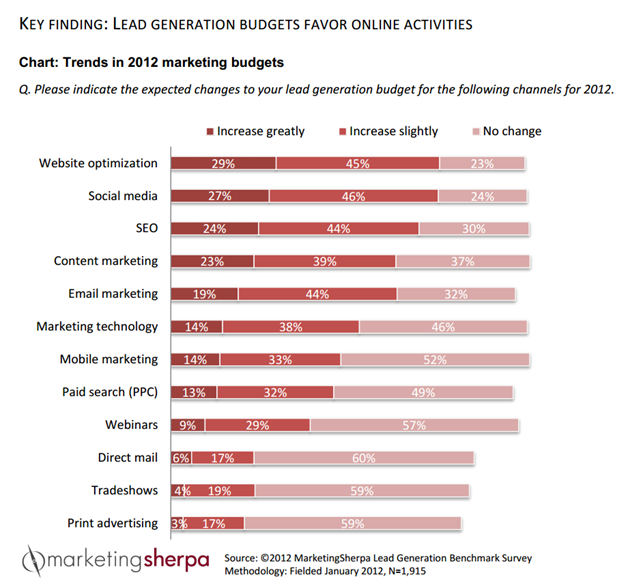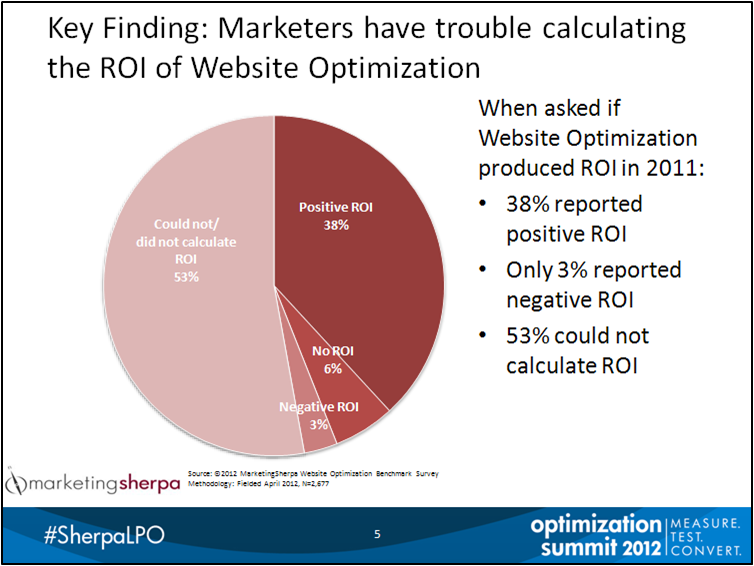Editor’s Note: One of the prizes of winning the MarketingSherpa Reader’s Choice Awards is the chance for a guest post here on the MarketingSherpa blog. Today’s post is by Tom Pick of Webbiquity, chosen as best B2B marketing blog … by you.
With more than 90% of B2B and high-value consumer product purchasing decisions now starting with online research, online visibility is crucial. Companies that seem to be “everywhere” online for specific search phrases, with relevant content, stand an outsized chance of winning the business.
Maximizing online visibility isn’t just a matter of search engine optimization (SEO), though that plays a key role. As prospective buyers look to influential third-party information sources as well as peer reviews in addition to vendor content, disciplines that have traditionally operated in silos (SEO, online advertising, social media, PR) need to work together in a coordinated fashion.
Content that is not coordinated between different functions (e.g., marketing emphasizes customer service while PR talks about new features) is confusing to prospective customers. Content that is re-created independently by different functions rather than created once and then repurposed is a waste of money. And, content that isn’t cross-linked for search optimization purposes is a missed opportunity.
But, as author Lee Odden points out in Optimize: How to Attract and Engage More Customers by Integrating SEO, Social Media, and Content Marketing, “For many companies, it can be very difficult and complex to implement a holistic content marketing and search optimization program.”
Read more…
According to the MarketingSherpa 2012 Lead Generation Benchmark Report (free excerpt at that link), 71% of survey respondents indicated that generating high-quality leads was a top challenge.
So, in today’s blog post, let’s look at lead generation budget trends (hint: money is moving to online tactics) and provide some resources to help you make wise use of that budget.

To help you get the most effective use of your budget, here are several case studies and how-to articles for some of the tactics mentioned in the above chart.
Read more…
In looking to improve the site search on MarketingSherpa (the site is 13 years old, and we have 2,991 case studies and articles, so an effective site search is crucial to helping you find marketing industry information to help you do your job better), the tech team here at MECLABS has explored different site search tools.
The team identified three predominant site search methods:
Method #1: Install a search engine on your own server
In our case, we were specifically looking at PHP scripts, since we use that on MarketingSherpa.
In general, there are two types of PHP or Perl search engine scripts. One will search your entire website for the relevant article each time your visitor invokes the search engine. The other creates an index of your site, and only searches the index when the visitor uses the engine.
The former is easier to configure and use for the newcomer, but it quickly becomes sluggish when your website grows big. The latter is more efficient, but often requires you to remember to re-index your site each time you change your pages.
Advantages:
- Customizable page results
- No third-party advertisements
- Re-index as needed
- Re-indexing your site does not increase your bandwidth utilization, unless the script accesses your site via HTTP
Disadvantages:
- Need PHP support on Web server
- Will need to be able to edit PHP to configure your site search tool
Some PHP Search Engine scripts:
Read more…
During our second annual MarketingSherpa and Marketing Experiments Optimization Summit 2012 two weeks ago in Denver, Dr. Flint McGlaughlin, Managing Director, MECLABS (the parent company of MarketingSherpa), presented some interesting data points on brand-new MECLABS research conducted by Meghan Lockwood, Senior Research Analyst, MECLABS, for the upcoming MarketingSherpa Website Optimization Benchmark Report.
I live blogged this material for MarketingExperiments, but I thought the research was worth sharing with our SherpaBlog readers as well.
One data point from this research from our Website Optimization Survey, which will be presented in an upcoming benchmark report, really stood out to me:

Click to enlarge
Read more…
 The Boston Globe has been in the content business for a long time. The newspaper published its first edition on March 4, 1872. Now in the digital age, it offers a free online version. At the end of last year, the company decided to include a premium, subscription-based digital version as well.
The Boston Globe has been in the content business for a long time. The newspaper published its first edition on March 4, 1872. Now in the digital age, it offers a free online version. At the end of last year, the company decided to include a premium, subscription-based digital version as well.
This blog post reveals an early, inside look at the approach The Boston Globe is taking to launch a paywall, complete with an honest look at a few bumps the marketing team hit along the way.
Peter Doucette, executive director of circulation, sales and marketing, The Boston Globe, will present further information about the newspaper’s marketing efforts at the MarketingSherpa and MarketingExperiments Optimization Summit in Denver, June 11-14.
THE CHALLENGE
The marketing challenge for The Boston Globe is maintaining two Internet offerings, one free and one paid.
Peter says the issue is to grow digital consumer revenue while at the same time maintain and grow digital advertising revenue.
“In the end, how do you take a prospect and turn them into a customer?” he asks.
Read more…
 We want to serve you better, so we’re conducting a quick survey to determine the best way. We’re interested only in aggregate needs and preferences, so individual responses are anonymous. Every respondent will, however, earn a free copy of a MarketingSherpa 30-Minute Marketer report – How to Integrate Social Media with Email and SEO.
We want to serve you better, so we’re conducting a quick survey to determine the best way. We’re interested only in aggregate needs and preferences, so individual responses are anonymous. Every respondent will, however, earn a free copy of a MarketingSherpa 30-Minute Marketer report – How to Integrate Social Media with Email and SEO.
And if there’s anything we learn from the survey that we think you might find valuable, we’ll publish it.
Take the survey now











